Naturalist Holidays
WILDLIFE EXPLORATIONS in the SOUTH OF FRANCE
by Linda and Rob Nottage 25 April - 3 May 2003
Rebinelle
 The
first thing that struck us on arrival at Rebinelle after the warm welcome from
Rachael and David to their delightfully restored and extended Provençal
farmhouse was the barrage of song from the local Nightingales. These birds continued
to serenade us night and day for the duration of our stay. Adding to the chorus
as we breakfasted on the balcony were Woodlark, Cirl Bunting, Bonelli’s
Warbler, Serin, Goldfinch and Tree Sparrow. Distinctive but hardly tuneful was
the creaking song of the Black Redstart whose mate was sitting on eggs in a
crevice in the farmhouse wall. Although the persistent calls of the Cuckoo were
unmistakable, ringing cries from the hillside were probably a Wryneck and the
“prrp” calls drifting down indicated the presence of Bee-eaters,
possibly migrating through.
The
first thing that struck us on arrival at Rebinelle after the warm welcome from
Rachael and David to their delightfully restored and extended Provençal
farmhouse was the barrage of song from the local Nightingales. These birds continued
to serenade us night and day for the duration of our stay. Adding to the chorus
as we breakfasted on the balcony were Woodlark, Cirl Bunting, Bonelli’s
Warbler, Serin, Goldfinch and Tree Sparrow. Distinctive but hardly tuneful was
the creaking song of the Black Redstart whose mate was sitting on eggs in a
crevice in the farmhouse wall. Although the persistent calls of the Cuckoo were
unmistakable, ringing cries from the hillside were probably a Wryneck and the
“prrp” calls drifting down indicated the presence of Bee-eaters,
possibly migrating through.
 Distant
flutings indicated that Golden Orioles had returned to the trees by the river,
and could those faint curlew-like cries have been the Stone Curlews we later
saw on shingle banks by the River Buech? Black Kites were often seen wheeling
above the valley, and Grey Herons floated down to their nests in trees on the
far bank. This was all in addition to the wonderful vista of hills and crags,
the apple orchards in blossom and the wide river valley across to the hilltop
village of Mison with its picturesque castle ruin.
Distant
flutings indicated that Golden Orioles had returned to the trees by the river,
and could those faint curlew-like cries have been the Stone Curlews we later
saw on shingle banks by the River Buech? Black Kites were often seen wheeling
above the valley, and Grey Herons floated down to their nests in trees on the
far bank. This was all in addition to the wonderful vista of hills and crags,
the apple orchards in blossom and the wide river valley across to the hilltop
village of Mison with its picturesque castle ruin.
 A
meander around the grassy hillside, scrub and open woodland behind the farmhouse
gave our first encounters with abundant Box, flowering Amelanchier and Quince
bushes, Early Spider and Lady Orchids (right). Clumps of Blue Aphyllanthes just
coming into bloom were easily recognised, but some of the yellow-flowered leguminous
plants tested our identification skills. There were also fritillary butterflies
and newly emerged Ascalaphids (yellow-winged relatives of ant-lions) fluttering
low over the ground.
A
meander around the grassy hillside, scrub and open woodland behind the farmhouse
gave our first encounters with abundant Box, flowering Amelanchier and Quince
bushes, Early Spider and Lady Orchids (right). Clumps of Blue Aphyllanthes just
coming into bloom were easily recognised, but some of the yellow-flowered leguminous
plants tested our identification skills. There were also fritillary butterflies
and newly emerged Ascalaphids (yellow-winged relatives of ant-lions) fluttering
low over the ground.
Patches of churned up ground indicated the presence of Wild Boar, which we never saw, apart from a lower jaw complete with powerful tusks found by Rachael down by the river. These animals are a prized quarry of hunters in the winter so are chiefly nocturnal and secretive. We did have good views of two Brown Hares but deer slots in the mud and a Badger sett showed the presence of other mammals.
It was difficult to get close to the river itself, which wound in braided channels through the shingle and boulder strewn course of its wide valley, flanked by belts of trees. Yellow-legged Gulls, White Wagtails and a migrating Greenshank competed for attention with the croaking of marsh frogs.
Panoramic ridge walk
 A
wonderful day’s ramble in glorious sunshine, with fantastic views across
the valley and beyond to the snow-capped Ecrins, and west towards Mont Ventoux.
David made the ascent to Mont Burlet at 1414m easy by taking us most of the
way up the rough track in the 4-wheel drive. On the way up we spotted Scarce
Swallowtails, Butterfly Orchids and a patch of Poet’s Narcissus. Once
on foot, we were soon distracted by abundant violets, Stinking Hellebore and
Hepatica in blue and white forms, with clumps of pale yellow Crested Lousewort
and Peony.
A
wonderful day’s ramble in glorious sunshine, with fantastic views across
the valley and beyond to the snow-capped Ecrins, and west towards Mont Ventoux.
David made the ascent to Mont Burlet at 1414m easy by taking us most of the
way up the rough track in the 4-wheel drive. On the way up we spotted Scarce
Swallowtails, Butterfly Orchids and a patch of Poet’s Narcissus. Once
on foot, we were soon distracted by abundant violets, Stinking Hellebore and
Hepatica in blue and white forms, with clumps of pale yellow Crested Lousewort
and Peony.
The track took us through a delightful beech wood just coming into leaf, with patches of Angular Solomon’s Seal, the bi-coloured Spring Vetchling, and the “dinky pinky” Rock-jasmine Androsace chaixii. Birds here were reminiscent of species at home - Robin, Chaffinch, Marsh Tit, etc.
Climbing the grassy slope to the mast on the summit of Mont Burlet, we found Grizzled Skipper, Green Hairstreak and elusive fritillary butterfly species, as well as the very localised Spring Ringlet. The turf was studded with a yellow, pink and blue display of potentillas, valerian and forget-me-not. Patches of Yellow Whitlow Grass on the limestone crag reminded us of its similar habit on the Gower cliffs in Glamorgan.
 The
path descended steeply through mixed pine, oak and beech woodland to the col
with a short stiff climb up the other side to Pic de St Cyr at 1365m, where
we enjoyed the panorama as we picnicked. From here it was gradually downhill
all the way following the crest path along the ridge, but making short forays
down the dip slope dotted with Meadow Saxifrage to admire clumps of Pasque flowers
(right), some of which were already in feathery fruit.
The
path descended steeply through mixed pine, oak and beech woodland to the col
with a short stiff climb up the other side to Pic de St Cyr at 1365m, where
we enjoyed the panorama as we picnicked. From here it was gradually downhill
all the way following the crest path along the ridge, but making short forays
down the dip slope dotted with Meadow Saxifrage to admire clumps of Pasque flowers
(right), some of which were already in feathery fruit.
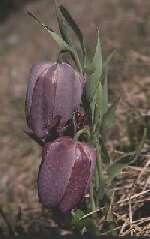 The
dark boxy bells of some of the abundant Tyrolean Fritillaries flowers had been
eaten and we soon found the crimson culprits, Lily Beetles, mating within the
blooms (highlighted left). In pockets on the crest where the limestone was exposed
we knelt to compare the tiny white flowers of Hutchinsia, Whitlow-grass and
Rue-leaved Saxifrage. We also grovelled ecstatically in admiration of the yellow
stars of the Wild Tulips Tulipa australis.
The
dark boxy bells of some of the abundant Tyrolean Fritillaries flowers had been
eaten and we soon found the crimson culprits, Lily Beetles, mating within the
blooms (highlighted left). In pockets on the crest where the limestone was exposed
we knelt to compare the tiny white flowers of Hutchinsia, Whitlow-grass and
Rue-leaved Saxifrage. We also grovelled ecstatically in admiration of the yellow
stars of the Wild Tulips Tulipa australis.
In addition to abundant Amelanchier, flowering shrubs included St. Lucie’s Cherry and the prostrate Wild Cotoneaster.
The natural rock garden was clothed in cinquefoils and both white and yellow Rockroses. There were houseleek rosettes and the fleshy leaves of Stonecrops which were being consumed enthusiastically by the distinctive orange-spotted black caterpillars of Apollo butterflies. Butterflies on the wing included Swallowtails, Orange Tips, Small Heaths and more Spring Ringlets. A Bloody-nosed Beetle lived up to its name by depositing a drop of red fluid when handled. A pair of Wheatears played hide-and-seek among the rocks and Skylarks sang while Swifts, Swallows and House Martins swooped low over the ridge. The avian highlight was undoubtedly the Short-toed Eagle which dangled its legs in characteristic fashion as it soared over allowing good views of its dark head and chest, barred white wings and tail.
Wren, Dunnock, Blackcap and Bonelli’s Warbler songs accompanied our steep descent through woodlands of Downy Oak and Pine, the latter decorated with the abandoned webs of Pine Processionary Moth larvae. We eventually emerged on to a grassy plateau above Antonaves from where David collected us for the short drive back to base. While waiting we noted Mountain Kidney Vetch, False Vetch and masses of small spurges and rockroses.
This was a wonderful introduction to the scenery, flora and fauna of Rebinelle’s backdrop.
Lac de Mison and Mison Castle
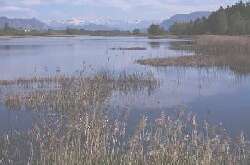 This
reed-fringed reservoir, only a short drive from Ribiers, has an idyllic setting
reflecting the distant snow-capped peaks. It held many familiar waterbirds including
Mute Swan, Mallard, Moorhen and Coot - a pair of these was feeding six tiny
chicks in the shallows. There were many Dabchicks, calling noisily, and smaller
numbers of Great Crested Grebes. A migrant Wood Sandpiper feeding unobtrusively
around the margin allowed good views both at rest and in flight. Only single
Reed and Great Reed Warblers were heard but more summer visitors were perhaps
still on their way to populate the reed-beds. Surrounding woodland and hedgerows
held Great Spotted Woodpecker, Nightingale, Tree Sparrow and Cetti’s Warbler.
This
reed-fringed reservoir, only a short drive from Ribiers, has an idyllic setting
reflecting the distant snow-capped peaks. It held many familiar waterbirds including
Mute Swan, Mallard, Moorhen and Coot - a pair of these was feeding six tiny
chicks in the shallows. There were many Dabchicks, calling noisily, and smaller
numbers of Great Crested Grebes. A migrant Wood Sandpiper feeding unobtrusively
around the margin allowed good views both at rest and in flight. Only single
Reed and Great Reed Warblers were heard but more summer visitors were perhaps
still on their way to populate the reed-beds. Surrounding woodland and hedgerows
held Great Spotted Woodpecker, Nightingale, Tree Sparrow and Cetti’s Warbler.
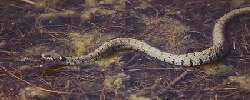 A
Grass Snake swam along the edge of the lake, presumably in pursuit of one of
the many “marsh” frogs (with a pale green stripe down their backs)
we saw around the margin. Also in the shallows lurked a large Crayfish with
red bands across its “tail”. Despite the fresh breeze, there were
a few Blue-tailed Damselflies, various butterflies including fritillaries, Painted
Lady and probable Osiris Blue, with abundant grasshoppers in the adjacent fodder
vetch field judging by their persistent chirps.
A
Grass Snake swam along the edge of the lake, presumably in pursuit of one of
the many “marsh” frogs (with a pale green stripe down their backs)
we saw around the margin. Also in the shallows lurked a large Crayfish with
red bands across its “tail”. Despite the fresh breeze, there were
a few Blue-tailed Damselflies, various butterflies including fritillaries, Painted
Lady and probable Osiris Blue, with abundant grasshoppers in the adjacent fodder
vetch field judging by their persistent chirps.
Grassy paths led from the quaint village of Mison around the castle mound giving extensive views along the Buech valley. It is possible to scramble up the stony ramp under a wallflower-decked archway to enter the heart of the ruin although this access is clearly “interdit”. We watched a Black Kite soaring with a much smaller raptor, probably a Sparrowhawk. Scarce Swallowtail and Wall Brown were among the butterflies flitting over turf dotted with Wild Thyme, Storksbill and Star of Bethlehem. Large leaf rosettes promised orchids to come.
Gorge de Meouge
The scenic waterfall and deep blue pool above the restored “Roman” bridge attracts bathers as well as sightseers. The river is an ideal spot for Dippers and Grey Wagtails while Crag Martins are at home around the limestone walls of the gorge. Buzzard and Raven also find this a suitable habitat. Along the narrow undulating path clinging to the precipitous side of the gorge were patches of Garden Iris (Iris germanica) with its deep purple blooms sprouting from the stony slopes. Manna Ash trees were in flower along with the more familiar Wayfaring Tree, while at our feet were Tassel Hyacinth, Cowslip and Hepatica, although we would need to be here at night to see the Nottingham Catchfly at its best. Flitting around the vegetation was a Wood White, but the cloudy skies perhaps suppressed other insect activity.
Regaining firm ground, we returned to the car on the road, and Rachael took us further on up the gorge before turning off onto a forest track which led to an open grassy clearing, well-known to her as a paragliding landing site. Here were more Lady and Early Spider Orchids, with lots of White Rockrose and scattered Globularia and Valerian.
Sisteron
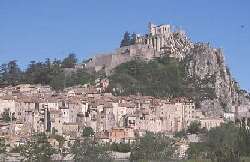 This
local centre has a dramatic setting at a narrowing of the River Durance, with
strata tipped almost vertically to form rock fins on each side. The citadel
towers precariously over the many-storeyed houses clinging to rock faces above
the river. Swifts and martins circled the buildings.
This
local centre has a dramatic setting at a narrowing of the River Durance, with
strata tipped almost vertically to form rock fins on each side. The citadel
towers precariously over the many-storeyed houses clinging to rock faces above
the river. Swifts and martins circled the buildings.
A nature trail (sentier botanique) has been well laid out through the mixed woods behind the town on the west, zig-zagging up the hillside to a viewpoint at 748m. Information boards identify all the main tree and shrub species en route, with a variety of herbs adding colour - Hepatica, Angular Solomon’s Seal, Dog Violets, Milkwort and Lady Orchids. In a clearing at the summit we found a patch of Violet Limadore in bud. In addition to songbirds familiar from British woods and the ubiquitous Nightingale, we enjoyed sightings of Firecrest, Crested Tit, and Treecreepers (almost certainly Short-toed). Continuous rain didn’t dampen our enthusiasm.
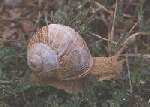 Fortified
by a traditional restaurant lunch and with the rain easing off we made a short
stop at a disused quarry on the minor road back to Ribiers. Snails were out
in force including the impressive Roman Snail (also on the restaurant menu,
but we weren’t tempted). A Redstart sang from a roadside oak and a Subalpine
Warbler showed off his smart plumage while singing his scratchy song. Flowery
verges near the town were dotted with Cowslips, Woad, Clary, Rock Soapwort,
Lady Orchid, Meadow Saxifrage and Blue Lettuce.
Fortified
by a traditional restaurant lunch and with the rain easing off we made a short
stop at a disused quarry on the minor road back to Ribiers. Snails were out
in force including the impressive Roman Snail (also on the restaurant menu,
but we weren’t tempted). A Redstart sang from a roadside oak and a Subalpine
Warbler showed off his smart plumage while singing his scratchy song. Flowery
verges near the town were dotted with Cowslips, Woad, Clary, Rock Soapwort,
Lady Orchid, Meadow Saxifrage and Blue Lettuce.
Les Demoiselles Coiffées, Mont Colombis, and via the Bès valley gorges to Digne
After first following the Route des Fruits et Vin up the Durance valley, we branched northwards through the precipitously perched village of Théus to view the amazing geological formations known locally as Demoiselles Coiffées. These pinnacles consist of naturally cemented pillars of morainic debris capped by large boulders, standing on the steep and unstable flanks of a large gully. Gaudy Moroccan Orange Tips as well as the usual swallowtail species floated past.
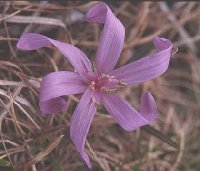 Continuing
up the hairpin bends, we reached the summit of Mont Colombis at 1733m, from
where there were superb views of snow-capped peaks all around, with the Lac
de Serre-Ponçon far below. In the north-facing open woodland of Larch,
Beech and some Juniper, a variety of spring flowers studded the short turf,
some sprouting within the patches of fast-melting snow. Sheets of White Crocus
with a few pink Spring Bulbocodium (right) scattered among them, patches of
purple pansies (Viola calcarata?), Mountain Lungwort, Spring and Trumpet Gentians,
and a white Rock-jasmine all competed for our attention. Primroses and Cowslips
were there too, but to appreciate the perfume of the few Daphne mezereum shrubs
needed care as some were embedded in the many large and active wood ant nests.
From the evidence of leaves alone, Trollius, False Helleborine and Aquilega
were soon to appear.
Continuing
up the hairpin bends, we reached the summit of Mont Colombis at 1733m, from
where there were superb views of snow-capped peaks all around, with the Lac
de Serre-Ponçon far below. In the north-facing open woodland of Larch,
Beech and some Juniper, a variety of spring flowers studded the short turf,
some sprouting within the patches of fast-melting snow. Sheets of White Crocus
with a few pink Spring Bulbocodium (right) scattered among them, patches of
purple pansies (Viola calcarata?), Mountain Lungwort, Spring and Trumpet Gentians,
and a white Rock-jasmine all competed for our attention. Primroses and Cowslips
were there too, but to appreciate the perfume of the few Daphne mezereum shrubs
needed care as some were embedded in the many large and active wood ant nests.
From the evidence of leaves alone, Trollius, False Helleborine and Aquilega
were soon to appear.
The woodland birds were active too; Nuthatch and Great Spotted Woodpecker called, Tree Pipits and Woodlarks performed their delicately musical song flights, while Chiffchaffs and Cuckoo broadcast their more monotonous signatures. The latter would perhaps have fancied the twitching masses of hairy Lackey-type caterpillars feeding on rockrose on the warmer southern slope.
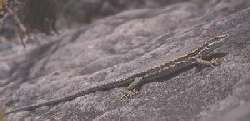 Descending
to the shores of the Lac, we stopped there for our picnic lunch where two Wall
Lizards entertained us with their territorial chases. Continuing south, we followed
the tumbling Bès river through its narrow gorges of Clue de Verdache
and Clue de Barles, which form part of an extensive Geological Reserve. A short
trail provided information posts about the Carboniferous fossil plants as well
as the rock types. Our driver screeched to a halt to enable us to admire the
splendid Green Lizard which dashed across the road and darted up a tree. We
were also impressed by the Andy Goldsworthy “cone” of stones in
the Clue de Barles, and the delicate Three-bracted Snakeshead there.
Descending
to the shores of the Lac, we stopped there for our picnic lunch where two Wall
Lizards entertained us with their territorial chases. Continuing south, we followed
the tumbling Bès river through its narrow gorges of Clue de Verdache
and Clue de Barles, which form part of an extensive Geological Reserve. A short
trail provided information posts about the Carboniferous fossil plants as well
as the rock types. Our driver screeched to a halt to enable us to admire the
splendid Green Lizard which dashed across the road and darted up a tree. We
were also impressed by the Andy Goldsworthy “cone” of stones in
the Clue de Barles, and the delicate Three-bracted Snakeshead there.
North of Digne we stopped to inspect the vast wall of fossil ammonites, up to 12 inches across, embedded in a single exposed layer of steeply sloping strata. Unfortunately there wasn’t time to explore the trail leading to an Ichthyosaur fossil, but we did pay a short visit to the pleasant grounds of the Digne Geological Museum with its many water features. The intriguing bones referred to as “Hydropithecus” or water monkey embedded in a mound of tufa failed to convince us of their authenticity.
A brief stop on the journey home at Chateau-Arnoux to view the reed-fringed lake added Little Egret to our bird tally, suggesting this site would warrant further exploration for waterbirds.
Orpierre, Chamouse and Rémuzat
The historic village of Orpierre is circled by cliffs and crags much favoured by the climbing fraternity and Crag Martins. A plaque details its connection with the House of Orange (and incidentally with Le Roi d’Angleterre). As with most villages, large Plane trees provide shade in the square and while enjoying a cup of coffee here we noticed a Redstart on the church steeple.
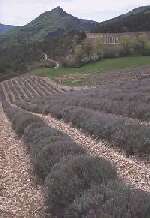 A
pleasant stream-side botanical trail with labelled plants including the True
Service Tree (another connection with Glamorgan flora) helped us to sort out
the identification of the various bewildering leguminous yellow-flowered shrubs.
In the sheltered valley butterflies were more active and included Green Hairstreak,
Dingy Skipper, Osiris Blue, Orange Tip and Scarce Swallowtail.
A
pleasant stream-side botanical trail with labelled plants including the True
Service Tree (another connection with Glamorgan flora) helped us to sort out
the identification of the various bewildering leguminous yellow-flowered shrubs.
In the sheltered valley butterflies were more active and included Green Hairstreak,
Dingy Skipper, Osiris Blue, Orange Tip and Scarce Swallowtail.
As we drove up the Col de Perty, we stopped briefly to watch a Short-toed Eagle, and again near the summit to photograph one of many Lavender fields. Between the compact rows of grey-green foliage (how beautiful they will look in purple bloom) the earth is neatly tilled and here we found an iridescent green ground beetle, Carabus auratus.
 From
the other side of the Col, David drove us up a steep side track which led eventually
to a deserted sheep farm which is used only in summer when the animals are brought
up to graze these higher pastures of Chamouse at about 1300m. The final ascent
was made on foot up a stony path through a beechwood with Seven-leaflet Bittercress
(or similar) just coming into bloom on the scree. On the grassy open hillside,
Cowslips, Meadow Saxifrage and intensely blue patches of Spring Gentian were
abundant. Ground-hugging White Candytuft and Rock-jasmine and the pink flower-heads
of Valerian were all common on the thin soils of the ridge while Pasque flower,
Tyrolean Fritillary, Green-winged Orchid, Gagea and Corydalis were scattered
elsewhere.
From
the other side of the Col, David drove us up a steep side track which led eventually
to a deserted sheep farm which is used only in summer when the animals are brought
up to graze these higher pastures of Chamouse at about 1300m. The final ascent
was made on foot up a stony path through a beechwood with Seven-leaflet Bittercress
(or similar) just coming into bloom on the scree. On the grassy open hillside,
Cowslips, Meadow Saxifrage and intensely blue patches of Spring Gentian were
abundant. Ground-hugging White Candytuft and Rock-jasmine and the pink flower-heads
of Valerian were all common on the thin soils of the ridge while Pasque flower,
Tyrolean Fritillary, Green-winged Orchid, Gagea and Corydalis were scattered
elsewhere.
Again we enjoyed wide-ranging views from Mont Ventoux in the west to the snow-capped Alpine ranges in the north and east. A wonderful place for a picnic in the sunshine! Skylarks, Woodlarks and Tree Pipits sang and Wheatears bobbed. Migrant Painted Ladies and Spring Ringlets were the commonest butterflies.
 Returning
to the vehicle, we drove on past more Lavender fields and orchards of Apricot,
Almond and Cherry via the Col de Soubeyrand to the village of Rémuzat.
Hemmed in on both sides by high cliffs and with an abattoir close by, it has
been the perfect spot for the reintroduction of Griffon Vultures. The colony
has thrived and attracted more birds from elsewhere so we had no difficulty
in watching over two dozen of these magnificent birds soaring round the cliffs
as we enjoyed hot drinks in the main square. An Egyptian Vulture joined their
aerial manoeuvrings. We could see tiny figures walking on the top of the crag
and obtained details from the information centre (whose frontage is decorated
with life-size cut-outs of the various raptor species found here) about access
through the village of St. May. From the car park it is only a 20 minute walk
between small fields and low scrub to the top of the vulture crag from where
one can look down on their 2.5m wingspans as they drift across the cliff-face
above Rémuzat square far below. Other treats at this site were the smart
Dartford Warbler which perched in full view for a minute or two and the clumps
of Swallow-wort beside the track.
Returning
to the vehicle, we drove on past more Lavender fields and orchards of Apricot,
Almond and Cherry via the Col de Soubeyrand to the village of Rémuzat.
Hemmed in on both sides by high cliffs and with an abattoir close by, it has
been the perfect spot for the reintroduction of Griffon Vultures. The colony
has thrived and attracted more birds from elsewhere so we had no difficulty
in watching over two dozen of these magnificent birds soaring round the cliffs
as we enjoyed hot drinks in the main square. An Egyptian Vulture joined their
aerial manoeuvrings. We could see tiny figures walking on the top of the crag
and obtained details from the information centre (whose frontage is decorated
with life-size cut-outs of the various raptor species found here) about access
through the village of St. May. From the car park it is only a 20 minute walk
between small fields and low scrub to the top of the vulture crag from where
one can look down on their 2.5m wingspans as they drift across the cliff-face
above Rémuzat square far below. Other treats at this site were the smart
Dartford Warbler which perched in full view for a minute or two and the clumps
of Swallow-wort beside the track.
The Camargue
Thick dark clouds and heavy rain which seemed to have set in for the day at Rebinelle was good enough encouragement to head south in search of better weather. The journey to Aix was quick and easy on the autoroute and after Fos sur Mer we began to see exciting birds on the old salt-pans beside the road. Cattle and Little Egrets, Shelduck, Avocets and especially the wonderfully pink Flamingos all caught our attention, as did the clumps of asphodel and an immature Great Green Bush-cricket.
 We
crossed the wide Grand Rhone river which forms the eastern boundary of the Regional
Park on the efficient car ferry at Bac de Barcarin. A short diversion south
to the observation platform overlooking the active salt workings gave extensive
views of the pans but few birds. We then wound our way northwards around the
edge of the Étang du Vaccarès on minor roads through rice fields,
scrubby salt meadows and tree-lined ditches. Here our progress was slow as we
kept stopping to enjoy every new bird - Marsh Harrier, Black-winged Stilt, Bee-eater,
Turtle Dove, Zitting Cisticola, Hoopoe, etc. One newly ploughed rice field held
particular attraction for a flock of Mediterranean Gulls in fine breeding plumage.
Yellow Irises and Giant Reeds dominated the ditches, which were home to noisy
frogs and a basking European Pond Terrapin.
We
crossed the wide Grand Rhone river which forms the eastern boundary of the Regional
Park on the efficient car ferry at Bac de Barcarin. A short diversion south
to the observation platform overlooking the active salt workings gave extensive
views of the pans but few birds. We then wound our way northwards around the
edge of the Étang du Vaccarès on minor roads through rice fields,
scrubby salt meadows and tree-lined ditches. Here our progress was slow as we
kept stopping to enjoy every new bird - Marsh Harrier, Black-winged Stilt, Bee-eater,
Turtle Dove, Zitting Cisticola, Hoopoe, etc. One newly ploughed rice field held
particular attraction for a flock of Mediterranean Gulls in fine breeding plumage.
Yellow Irises and Giant Reeds dominated the ditches, which were home to noisy
frogs and a basking European Pond Terrapin.
By now it was sunny and warm so we stopped for lunch overlooking an area of saline pasture and scrub. Mosquitoes were thankfully few this early in the year. Other insects were on the wing; Clouded Yellow and Painted Lady butterflies and an unidentified dragonfly zoomed past. A strikingly plumaged Yellow Wagtail perched obligingly on the fence for us to admire and debate its full identity which we concluded was of the subspecies cinereocapilla. A pair of Spectacled Warblers was equally confiding and the male performed his song for us.
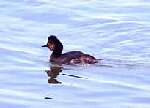 There
were more Flamingos, Coots and Great Crested Grebes on the Étang du Vaccarès,
but a Black-necked Grebe (right) in breeding finery close to the shoreline caught
our eye. From a roadside viewing platform overlooking freshwater marshes we
watched a feeding party of Wood Sandpipers and Ruff as well as the protruding
scaly back of a large Carp loafing in the shallows.
There
were more Flamingos, Coots and Great Crested Grebes on the Étang du Vaccarès,
but a Black-necked Grebe (right) in breeding finery close to the shoreline caught
our eye. From a roadside viewing platform overlooking freshwater marshes we
watched a feeding party of Wood Sandpipers and Ruff as well as the protruding
scaly back of a large Carp loafing in the shallows.
 The
two characteristic animals of the Camargue were also present in some numbers.
We were glad that a field full of fierce black bulls was well fenced, but the
white stallions and mares with their brown foals were more docile.
The
two characteristic animals of the Camargue were also present in some numbers.
We were glad that a field full of fierce black bulls was well fenced, but the
white stallions and mares with their brown foals were more docile.
At four o’clock we finally arrived at the main park information centre, well set up with a big picture window overlooking a lake, where a large rodent (Coypu or Muskrat) desported itself and a single Spoonbill on the far side was busy preening. A pair of Mute Swans tended their five small cygnets. Although the Camargue is famed for its wintering waterbirds, these together with Mallard, Gadwall and Shelduck were the only wildfowl species we saw. Because it was a public holiday, the adjacent Ornithological Trails were very busy, and in any case we were running out of time so reluctantly we had to turn for home, although well pleased with our first visit to the Camargue. A prominent landmark seen on the return journey through Aix was Mont Sainte-Victoire, a famous subject of the painter Cézanne.
Conclusion
Our wonderful week provided merely a snapshot of the superb scenery and habitats within easy reach of our base, and the variety of wildlife to be found there. A longer stay and more intensive observation and research would reveal even more riches.
The timing of our visit meant that springtime bird activity was probably at its peak, with migrants well represented in our list of almost a hundred species. The colourful array of spring flowers will give way to other species as summer progresses and we would expect insect life, especially the butterflies, to reach its peak in the warmer months.
 Our
thanks to Rachael, David and Margaret for making it all such an enjoyable experience.
Our
thanks to Rachael, David and Margaret for making it all such an enjoyable experience.
We hope to return next year!
Linda and Rob Nottage
June 2003